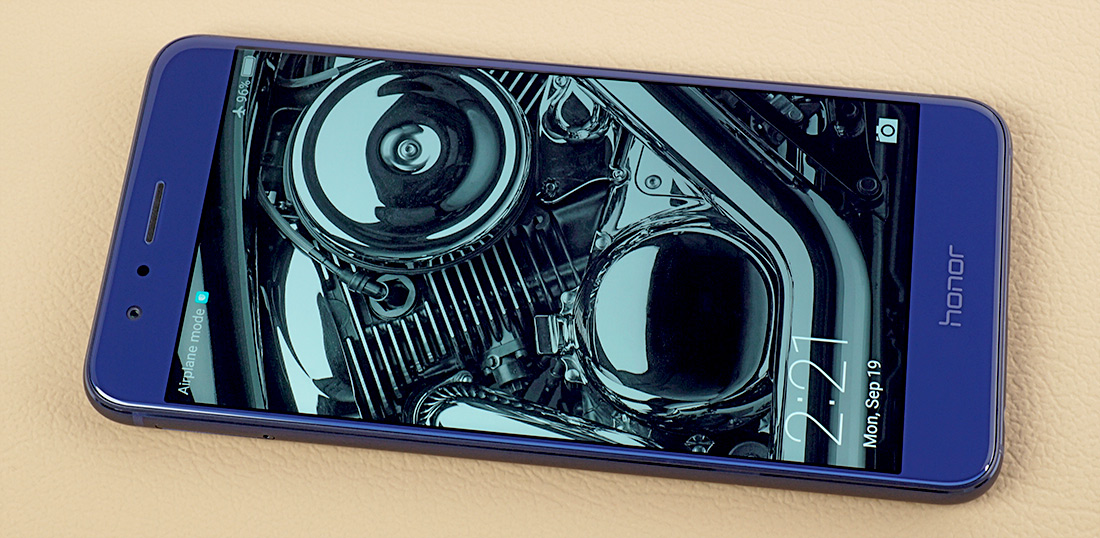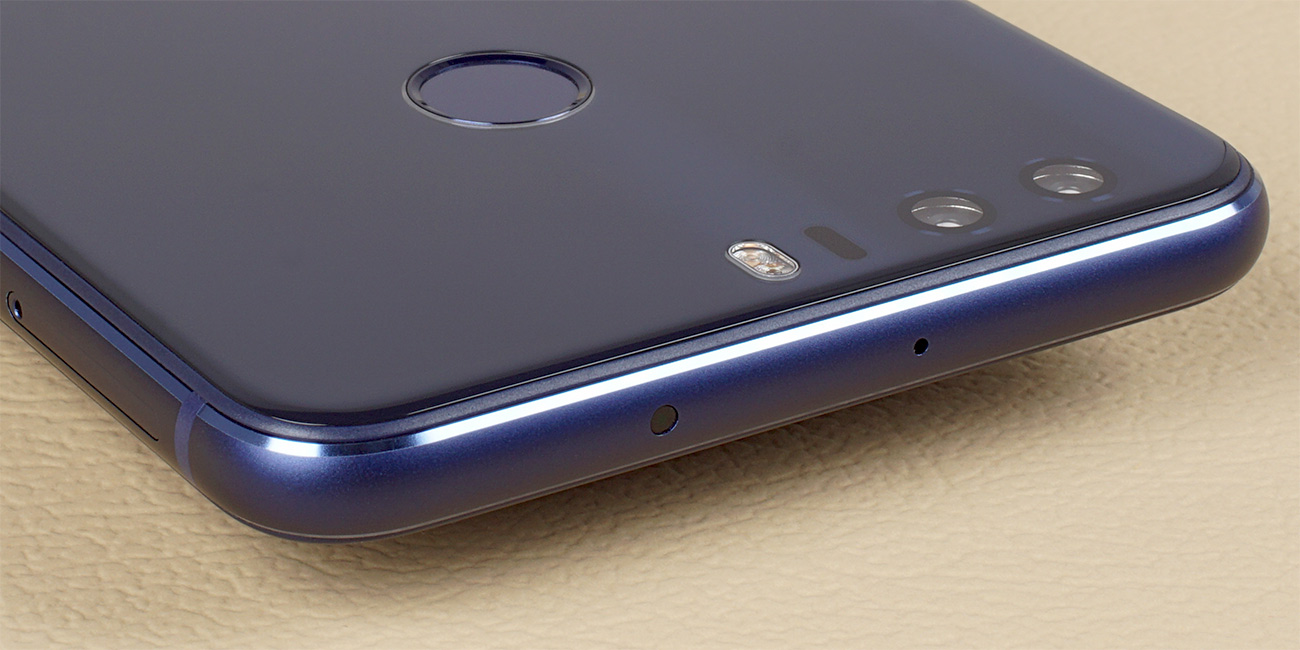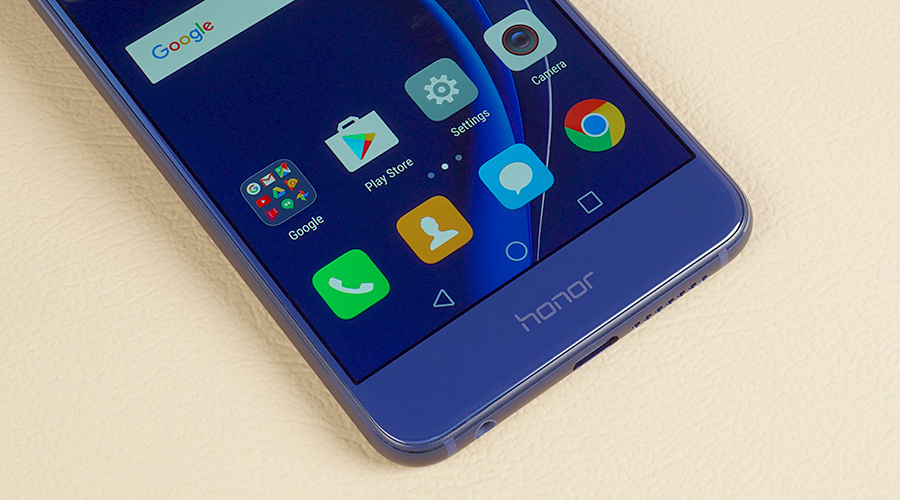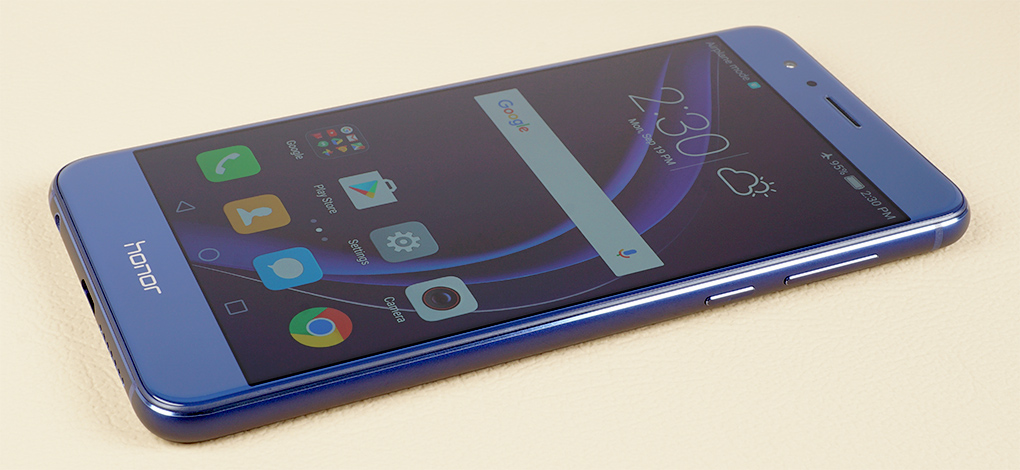The Huawei Honor 8 Review
by Matt Humrick on October 13, 2016 8:00 AM EST- Posted in
- Huawei
- Smartphones
- Mobile
- Kirin 950
- honor
Final Words
Just like it did with the Honor 5X, Huawei has done a good job finding the right balance between features, performance, and price for the Honor 8. It’s not perfect (I’ve yet to see a phone that is), but it shows a level of polish that other phones at this price and below lack. In a way, the Honor 8 is sort of a sleeper. Sitting among the nearly two dozen phones currently on my desk, the Honor 8 does not really stand out, but if I were to arrange them in a stack from least likely to most likely to use, I would put it near but not at the top.
This polish is most evident in its design and build quality. The Honor 8 looks and feels like a premium phone, with nicely chamfered edges, flush cameras, shimmering surfaces, and rounded corners. The ergonomics are good too: The rear-mounted fingerprint sensor and power/volume buttons are within easy reach, but sit high enough to avoid accidental presses.
Personally, I would prefer to see metal rather than glass on the back, however. Glass attracts more fingerprints, is more likely to slide from your hand or off a table, and is less durable if dropped. This last point is especially relevant for the Honor 8 because the rear glass also covers the camera lenses. If the glass cracks in the upper-left corner from a drop, it could render the rear camera unusable. Most of these issues go away if you slip it into a case, though.
The Cortex-A72 CPUs, 3-4GB of LPDDR4 RAM, and Huawei’s under-the-hood software tweaks combine to make the Honor 8 feel plenty fast. It performs common tasks, including opening and switching between apps and browsing the web, as fast or faster than some flagship phones, and it remains fluid while scrolling and during other UI interactions. There’s still some jank in third-party apps, but this has more to do with poor app design than the phone itself.
While its Mali-T880MP4 GPU supports the latest graphics APIs and is capable of playing most modern Android games, the Honor 8 is not really a phone for gamers. The four core GPU configuration severely limits peak performance to the point where it could struggle with some titles.
The Honor 8’s battery is not particularly large, and with its high level of performance, battery life is a natural concern. Our tests, however, show that its battery life is no worse than similarly sized competitors such as the Samsung Galaxy S7; it even outlasts the current flagships in our web browsing battery test. With 8 hours of screen on time in PCMark’s battery test, the Honor 8 should have no trouble lasting an entire day on a single charge for most users.
The dual rear camera takes some very nice photos and even decent video, but it’s not good enough to beat out the single cameras belonging to some of the current flagship phones such as the Galaxy S7, at least not in all scenarios. It does well with exposure and white balance in general, and during the day or in good lighting it captures a lot detail with very little noise. Low-light performance is not quite as good, often producing blurry images when the autofocus system fails to acquire a target. This can usually be mitigated by tapping to focus, but there’s no solution for its poor HDR performance.
The rear camera’s simulated wide aperture feature is a nice bonus. It uses the dual rear cameras to capture a depth map that allows you to create some very nice looking simulated bokeh effects. It even allows you to change the object in focus and the amount of blur after the image is taken. The feature works well and is a definite value add for people who enjoy taking creative photos.
The one area where the Honor 8 really falls short is the display. It uses a quality panel that delivers a respectable peak brightness and a good black level, but Huawei does a really poor job with calibration. The overly cool white point and RGB imbalance leads to poor grayscale performance and a screen with an obvious blue or turquoise tint. It’s possible to adjust the Honor 8’s white point, but it does not fully fix the grayscale issue and just makes the problem worse in most cases. Its use of a wide color gamut panel also leads to inaccurate, oversaturated colors. People who prefer more vivid colors probably will not mind, but those who prefer color accuracy will be disappointed that there’s no sRGB mode. Beyond the grayscale and color issues, the panel on our Honor 8 shows a red-tinted sheen and reduction in brightness when viewing the screen tilted at even a small angle or slightly off center that does not occur with most IPS displays.
The Honor 8 finds itself in an interesting position. In the US market, there’s quite a few phones to choose from at the high end and the low end, but good phones in the middle are difficult to find. The OnePlus 3 and Moto Z Play both cost about the same as the Honor 8, have better displays, and competitive cameras, but are larger 5.5-inch phones that may turn some people off. If you’re looking for something a bit smaller that costs less than the HTC 10 or Galaxy S7, but still want a polished user experience, the Honor 8 is a pretty good phone that’s worth a look.















95 Comments
View All Comments
hemedans - Thursday, October 13, 2016 - link
its not efficient compare to 820 check gsmarena for batterylife, compare it with sd820 phone with 1080p display like xiaomi mi5-honor 8 endurance 70h
-xiaomi mi5 endurance 92h
xiaomi did beat honor 8 in all three test call, browsing and video playback
Impulses - Thursday, October 13, 2016 - link
Will be interesting to see where the Pixel falls: 820 + 1080p - slightly smaller battery + better optimizations, you'd hope.Impulses - Thursday, October 13, 2016 - link
821 rather...Meteor2 - Thursday, October 13, 2016 - link
Hmmm? Gsmarena lists specs, not test results. The test results in this review demonstrate that this phone is very efficient.LauRoman - Thursday, October 13, 2016 - link
But the Qualcomm is way more compatible, with play store apps. Sure, for the average joe, the facebook apps work on almost anything, but when you find a game or some other app that won't work ypu're gonna be so mad.Gordonium - Friday, October 14, 2016 - link
Wheres that come from? Kirin use ARM cores and ARM GPU, which makes it just as compatible as samsung exynos. I think most developers will expect their apps to run on a samsung.close - Friday, October 14, 2016 - link
Everybody knows you shouldn't buy Asian phones since they will probably not be compatible with American or European hands and ear/mouth placement. And let's not forget the vast number of applications that simply won't start on a blue phone.LauRoman can only confirm that Anandtech's readerbase just hit a new low.
ianmills - Sunday, October 16, 2016 - link
Are you the ghost of steve jobs?Lolimaster - Friday, October 14, 2016 - link
There are many games that are kind of broken with mali gpu's. You can see a video of gta san andreas on exynos vs snapdragon.negusp - Friday, October 14, 2016 - link
You have no idea what you're talking about. I think you're referring to x86 CPUs (Intel Atom), which aren't compatible with quite a few apps.The Kirin and Qualcomm SoCs are ARM and therefore have pretty much the same compatibility with all apps.